Time to Clean Your Dryer Ducts – Prevent Fires
Once the weather turns cold and the heat kicks on, your home starts to get dry and static electricity arrives once again. This minor nuisance that causes siblings to shock each other for fun can actually be dangerous if it ignites lint that has built up in or around your dryer.
Why you should clean out your dryer ductwork:
According to The Consumer Product Safety Commission, ( CPSC ), annually there are tens of thousands of Dryer Fires leading to many injuries or death, due to dryer exhaust duct fires. You should clean your dryer hose and around it once a year, and inspect the vent and hose for any blockages at least every 6 months.
You could pay a professional to clean your dryer ductwork, but the price could be anywhere from $65.00 to $150.00! Ummm — no thanks — I’ll keep my money and do this myself. It only takes about 15 – 20 minutes to do and it is easy! As long as your ductwork is fairly accessible, you can handle this!
If your dryer exhaust hose tube is longer than 10′ this may be a bit more difficult. And if it is longer than 10′, did you know that your dryer may be working extra hard to dry your clothes? Worse yet is if you have a long tube that goes up into the attic (or the eaves) and then out the roof. The warm moist air from the dryer enters the cold attic, and condensation forms in the exhaust tube. Do you know where this little story is going? Well, at first your dryer can’t dry as quickly because the tube is blocked by water. Eventually it will fill with enough water to cause the exhaust tube to split and guess where all that water goes? Through your ceiling, that is where! Trust me on this one, it happened to us in our old house.
So, why don’t you sit back down and let me give you a little tutorial on cleaning out your dryer exhaust ductwork.
Instructions:
Start by unplugging your dryer and turn off the gas if you have a gas dryer.
Remove your lint trap and remove any lint from the screen.
Using a brush (designed for cleaning out the coils under your fridge) bend the brush and run it inside the lint trap. Then follow up by using a shop vac or vacuum to suck up any lint and dirt loosened by the brush.
Pull the dryer away from the wall and disconnect the exhaust duct tube from the wall and the dryer. There are normally two kinds of hose clamps holding the tube to the dryer and wall port. The first is a ring with two prongs. Simply squeeze the prongs toward one another to loosen the clamp.
The second type of hose clamp requires a screwdriver to loosen the bolt attached to the clamp.
Slide the exhaust tube off the dryer and the port (hole in the wall.)
Use your vacuum to clean out both the dryer and wall ports.
Then use the vacuum to clean out the dryer exhaust tube.
If you have an older style vinyl tube, it is important that you replace it with a metal one. The vinyl and foil ones are fire hazards. Also, if you can’t get your tube clean, go ahead and replace it.
If your tube is long or difficult to clean out, you may want to purchase a hose brush like this one:
 Amazon.com: Brushtech B68C 10-Feet Long Dryer Vent Duct Cleaning Brush: Home & Garden. (affiliate link)
Amazon.com: Brushtech B68C 10-Feet Long Dryer Vent Duct Cleaning Brush: Home & Garden. (affiliate link)
While you have the dryer pulled out, vacuum off the back of the dryer, the washer, and the wall behind both. Eliminate as much lint as possible. A clean laundry room is safer than a lint covered one.
Re-attach the dryer tube to the wall and the dryer.
Gently push the dryer back towards the wall being careful not to crush the tube.
Locate your exterior dryer vent.
If you can reach the exterior vent, go ahead and clean it out also. Make sure the vent closes properly when the dryer isn’t running.Otherwise you may get birds, rodents or bugs in your vent. I don’t think I need to tell you that they won’t be helping your dryer’s efficiency!
And that is it?! That was easy wasn’t it. Be sure to keep your home and family safe by cleaning your dryer exhaust ductwork yearly.
Update: I wanted to let y’all know that the flex foil pipe shown in this tutorial is FLAMMABLE! Luckily I found this out before we had a fire.
Read about installing semi-rigid non-combustible duct in this easy tutorial!
You might also like:
Learn how to keep your HE Washer Clean like the day it was delivered!
DIY Laundry Detergent & Miracle Stain Remover

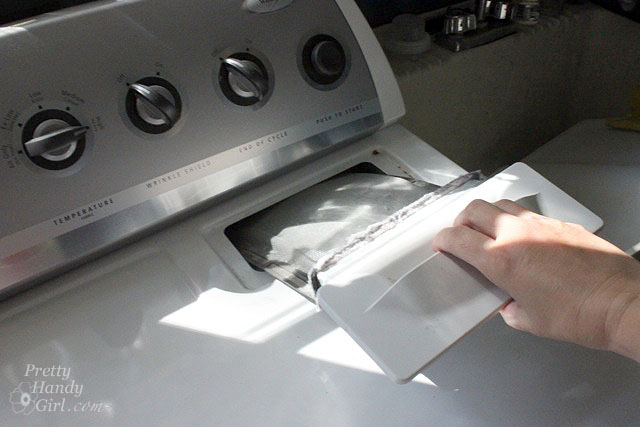
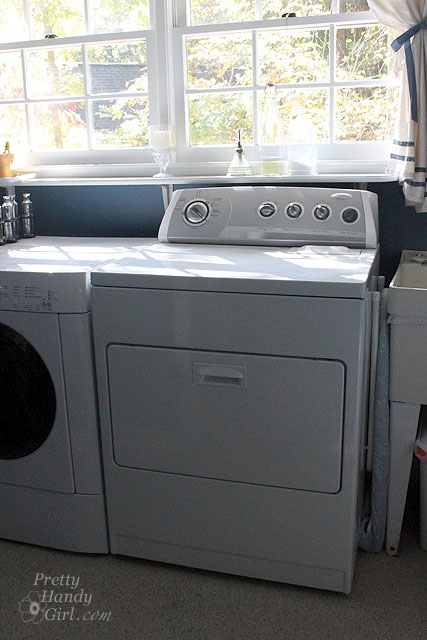
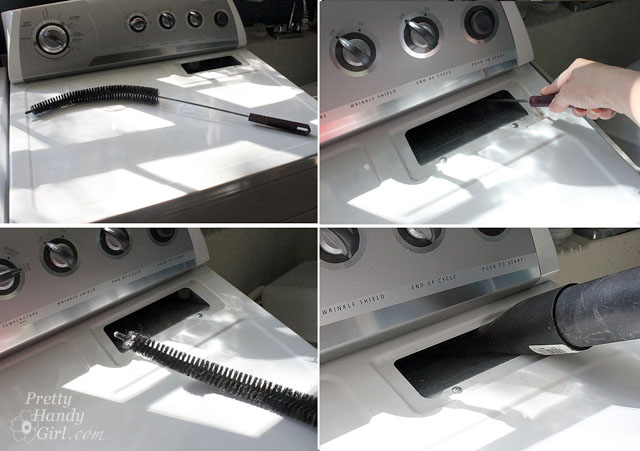

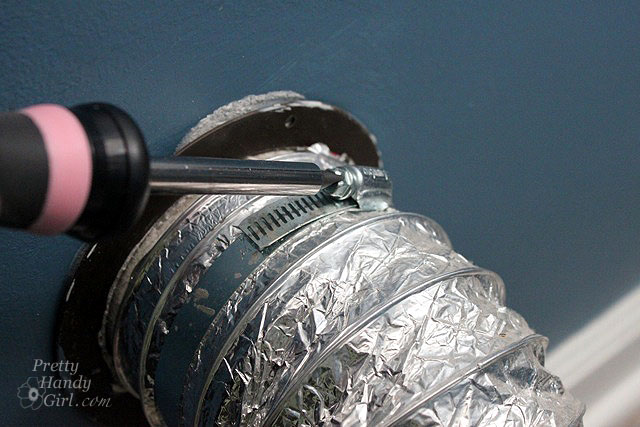

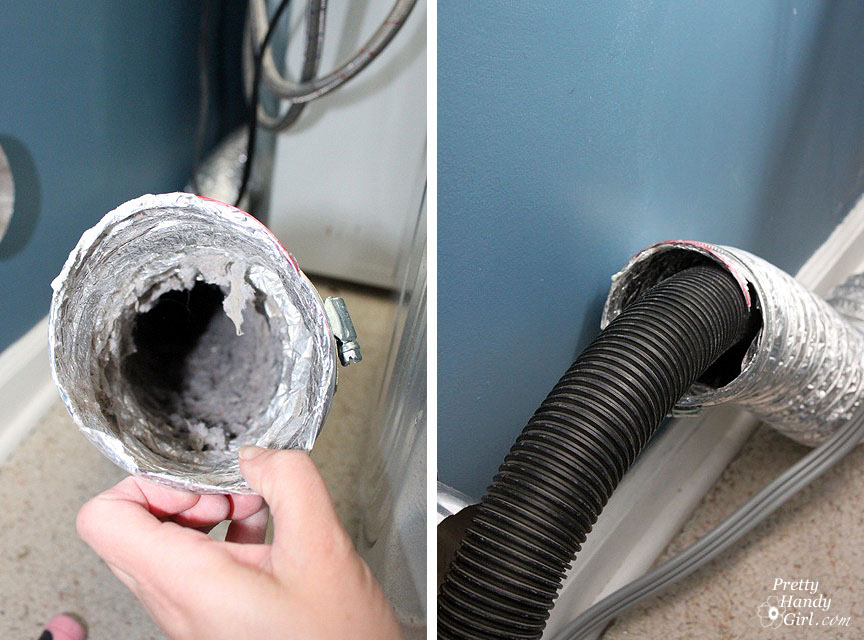

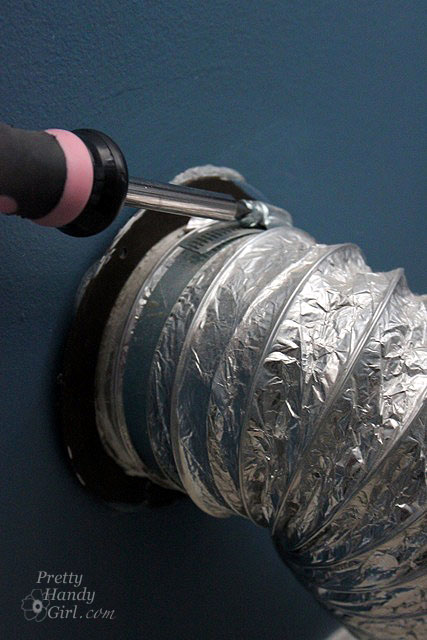
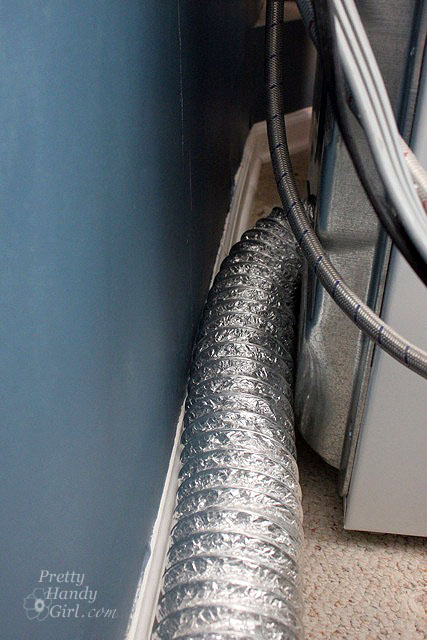
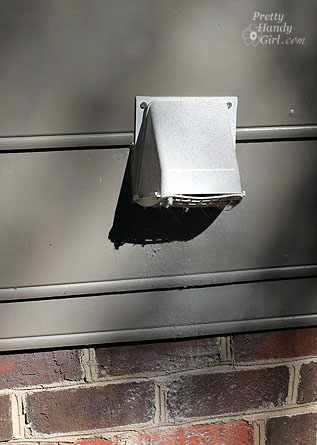
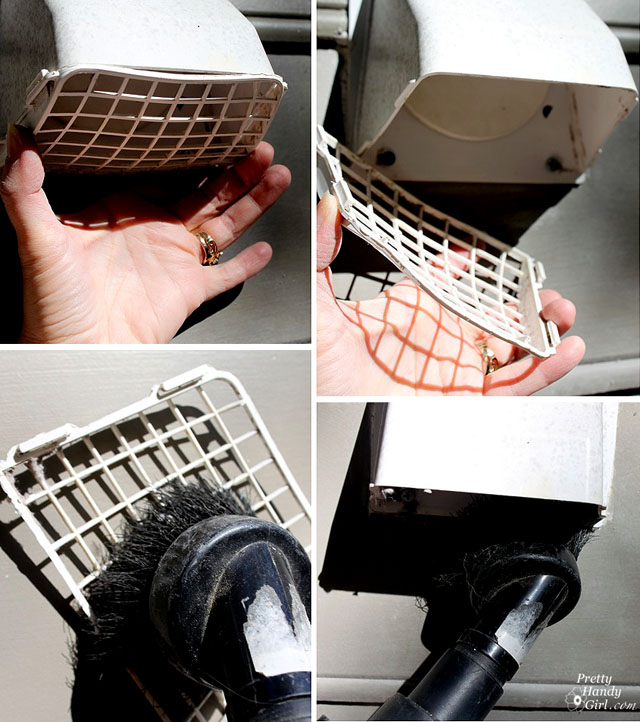
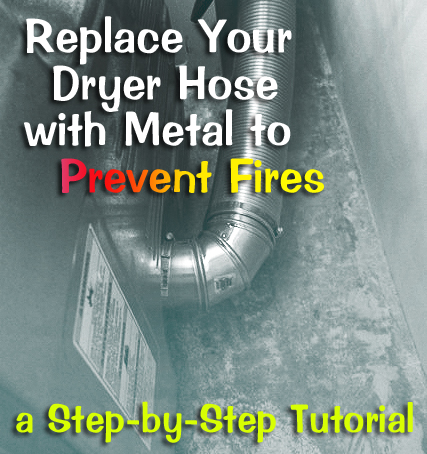




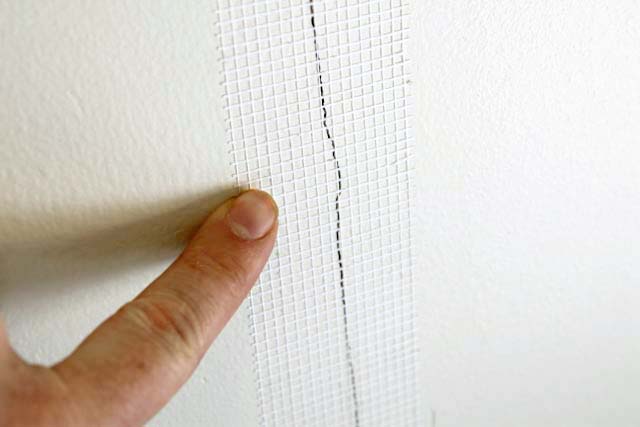


I apologize if this has already been mentioned but use your shop-vac not only to vacuum it out but to also blow it out! We take off the cover of the vent outside and then after vacuuming what we can we blow and that shoots a lot of stuff out of the vent. Then we vacuum from the outside too. We have a serious problem with the amount of lint we are accumulating and are thinking about replacing the lint trap screen to see if that helps. (though it is only 5years old)
I live in an apartment and have one of those combo/compact washer/dryer units. Any tips?
Gina, does the dryer have a duct running out the back? If not, you might need to do a little more research. I know when we were in Europe, there were lots of those. One I learned you had to empty a water reservoir when it filled.
Hi. I came across your post today while searching for ways to clear out my dryer vent. I recently discovered I have something living in the tubing, and at first thought it was lizards. I saw what I deduced to be lizard poop near the area in my apartment. My dog was always sniffing around the dryer area inside, and the vent on the outside, yet I never saw anything except the poo. Last week I told maintenance about it, but as of today, still nothing was done. I decided to take it into my own hands and see if I could get it all straightened out. I have never hooked up or unhooked a dryer before. Someone has always done it for me.
The other day I saw a sprig of leaves sticking out of the vent outside. Whatever it was was not lizards, and had pulled it into the vent to build up their nest. By this time I was thinking mice or something similar.
Today, I pulled out the dryer, and the tubing came off on its own when I pulled the dryer out too far. I then saw what looked like fur sticking out the end of the tube. The it moved, and I freaked out. I got a pillowcase around the end, and got another pillowcase and put it around the other end when I got it unhooked from the wall. I put on gloves (just in case whatever it was tried to bite me), twisted up the ends of the pillowcases around the ends of the tube, and took it outside to the grass, behind some garages. When I dumped it out onto the ground, a young possum came out, and ran off. Needless to day, I was a bit shocked when I saw something that big come out of my dryer tubing, since I was expecting maybe mice or something way smaller. This little guy had brought leaves into the tube, and also into the hole leading into my dryer. I am so glad I went with my instinct and took it all apart, because I really do not need a fire in my apartment. I also didn’t want to hurt whatever was in the tube by running the dryer. I got leaves out of the elbow from the dryer, the hole in the dryer, and the tube itself. Because of the possum, there was no lint buildup in there. So I guess that was one good thing! LOL
Sorry for being so long-winded. I just wanted to share my adventure with someone. But now that I know how to do it myself, I will try to remember to check it more often for lint buildup. I do know about the waxy buildup on the screen lint trap, so I do try to keep that clean. I keep an old toothbrush and after drying a load, I pull of the lint, then scrape the toothbrush over the edges and the screen to get the little lint pieces off.
Thank you for your helpful tips, and all the great comments on here, offering further advice and tips. I’m glad I found your site today. Have a great holiday weekend!
Wow! What a great story with a happy ending. My goodness, a possum! LOL. And so funny that it brushed the lint out for you ;-D. Ask mainenance to put a new vent exhaust on the outside with a cage.
I always clean the lint on the mesh after every dryer load. My husband says that is very important and usually sufficient.
Though, I might have to call the apartment’s maintenance folks to clean dryer ducts; don’t want to take the risk of causing fires!
I appreciate that you’re aware of dryer fires and that do it yourself is an admirable quality to have. However, there are 3 issues that need to be addressed here : 1) what if the homeowner has a gas dryer and 2) the type of dryer vent that you have in the picture is a fire hazard ( it’s clearly stated on the warning label at the back of the dryer … DO NOT USE PLASTIC , DO NOT USE FOIL …. FAILURE TO FOLLOW THESE INSTRUCTIONS CAN RESULT IN FIRE OR DEATH.
and #3) Dryer fires most often occur INSIDE THE DRYER where lint accumulates on the heater and then spreads to the rest of the venting.
Getting back to what if the homeowner has a gas dryer … well, I think that’s quite obvious really, you’re playing with danger here – carbon monoxide is definitely a huge concern.
Pay the money and get a professional dryer fire prevention company to do the work – and make sure that if you have a gas dryer that a qualified licensed gas technician is working on your unit. Saving your home , your life and your family’s life is really much more important that a bit of money for safety and piece of mind.
Thanks for promoting the awareness – but remember- most people would not be able and should not attempt to service their dryer vents especially if it’s a roof vent – could be very dangerous – just not worth it.
Joe, excellent points, thanks for taking the time to share with my audience!
This a perfect DIY post. Great to do at the change of each season or more often if you wash a dozen loads of laundry each week. 🙂